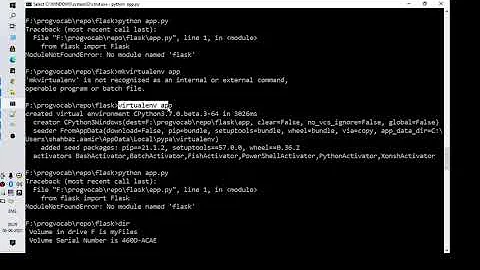bash: mkvirtualenv: command not found
Solution 1
Solution 1:
For some reason, virtualenvwrapper.sh installed in /usr/bin/virtualenvwrapper.sh, instead of under /usr/local/bin.
The following in my .bash_profile works...
source "/usr/bin/virtualenvwrapper.sh"
export WORKON_HOME="/opt/virtual_env/"
My install seems to work fine without sourcing virtualenvwrapper_bashrc
Solution 2:
Alternatively as mentioned below, you could leverage the chance that virtualenvwrapper.sh is already in your shell's PATH and just issue a source `which virtualenvwrapper.sh`
Solution 2
Try:
source `which virtualenvwrapper.sh`
The backticks are command substitution - they take whatever the program prints out and put it in the expression. In this case "which" checks the $PATH to find virtualenvwrapper.sh and outputs the path to it. The script is then read by the shell via 'source'.
If you want this to happen every time you restart your shell, it's probably better to grab the output from the "which" command first, and then put the "source" line in your shell, something like this:
echo "source /path/to/virtualenvwrapper.sh" >> ~/.profile
^ This may differ slightly based on your shell. Also, be careful not to use the a single > as this will truncate your ~/.profile :-o
Solution 3
I had the same issue on OS X 10.9.1 with python 2.7.5. No issues with WORKON_HOME for me, but I did have to manually add source "/usr/local/bin/virtualenvwrapper.sh" to ~/.bash_profile (or ~/.bashrc in unix) after I ran pip install virtualenvwrapper
Solution 4
Prerequisites to execute this command -
-
pip (recursive acronym of Pip Installs Packages) is a package management system used to install and manage software packages written in Python. Many packages can be found in the Python Package Index (PyPI).
sudo apt-get install python-pip
-
Install Virtual Environment. Used to create virtual environment, to install packages and dependencies of multiple projects isolated from each other.
sudo pip install virtualenv
-
Install virtual environment wrapper About virtual env wrapper
sudo pip install virtualenvwrapper
After Installing prerequisites you need to bring virtual environment wrapper into action to create virtual environment. Following are the steps -
-
set virtual environment directory in path variable-
export WORKON_HOME=(directory you need to save envs) -
source /usr/local/bin/virtualenvwrapper.sh -p $WORKON_HOME
As mentioned by @Mike, source `which virtualenvwrapper.sh` or which virtualenvwrapper.sh can used to locate virtualenvwrapper.sh file.
It's best to put above two lines in ~/.bashrc to avoid executing the above commands every time you open new shell. That's all you need to create environment using mkvirtualenv
Points to keep in mind -
- Under Ubuntu, you may need install virtualenv and virtualenvwrapper as root. Simply prefix the command above with sudo.
- Depending on the process used to install virtualenv, the path to virtualenvwrapper.sh may vary. Find the appropriate path by running $ find /usr -name virtualenvwrapper.sh. Adjust the line in your .bash_profile or .bashrc script accordingly.
Solution 5
Use this procedure to create virtual env in ubuntu
Step 1
Install pip
sudo apt-get install python-pip
step 2
Install virtualenv
sudo pip install virtualenv
step 3
Create a dir to store your virtualenvs (I use ~/.virtualenvs)
mkdir ~/.virtualenvs
or use this command to install specific version of python in env
virtualenv -p /usr/bin/python3.6 venv
step 4
sudo pip install virtualenvwrapper
step 5
sudo nano ~/.bashrc
step 6
Add this two line code at the end of the bashrc file
export WORKON_HOME=~/.virtualenvs
source /usr/local/bin/virtualenvwrapper.sh
step 7
Open new terminal (recommended)
step 8
Create a new virtualenv
mkvirtualenv myawesomeproject
step 9
To load or switch between virtualenvs, use the workon command:
workon myawesomeproject
step 10
To exit your new virtualenv, use
deactivate
and make sure using pip vs pip3
OR follow the steps below to install virtual environment using python3
Install env
python3 -m venv my-project-env
and activate your virtual environment using the following command:
source my-project-env/bin/activate
or if you want particular python version
virtualenv --python=python3.7.5 myenv
Related videos on Youtube
Comments
-
 Mike Pennington about 2 years
Mike Pennington about 2 yearsAfter following the instructions on Doug Hellman's
virtualenvwrapperpost, I still could not fire up a test environment.[mpenning@tsunami ~]$ mkvirtualenv test -bash: mkvirtualenv: command not found [mpenning@tsunami ~]$It should be noted that I'm using
WORKON_HOMEthat is not in my$HOME. I tried looking for/usr/local/bin/virtualenvwrapper.shas shown in thevirtualenvwrapperinstallation docs, but it does not exist.I'm running CentOS 6 and python 2.6.6, if this matters.
# File: ~/.bash_profile # ... export WORKON_HOME="/opt/virtual_env/" source "/opt/virtual_env/bin/virtualenvwrapper_bashrc" -
Gregology about 10 yearsWhere did you manually add source "/usr/local/bin/virtualenvwrapper.sh"?
-
Nick Benes about 10 years@Gregology I added that line to
~/.bash_profile. Note that when you first add it you'll either have to reload the terminal (which runs.bash_profile) or just run thatsourcecommand directly from the command line. -
Pierre de LESPINAY over 9 yearsSetting
WORKON_HOMEto "~/.virtualenvs" (default value) allows to set private virtualenvs -
 JGallardo over 8 yearsIt would be very helpful if you had a title with the filename and displayed all the contents so you don't have to get followup questions about "where did you put it?"
JGallardo over 8 yearsIt would be very helpful if you had a title with the filename and displayed all the contents so you don't have to get followup questions about "where did you put it?" -
 Toby Speight almost 8 yearsWhile this might be a valuable hint to solve the problem, an answer really needs a bit more detail than this. Please edit to explain how this will solve the problem. Alternatively, consider writing this as a comment instead.
Toby Speight almost 8 yearsWhile this might be a valuable hint to solve the problem, an answer really needs a bit more detail than this. Please edit to explain how this will solve the problem. Alternatively, consider writing this as a comment instead. -
 tripleee almost 8 yearsWhether you use
tripleee almost 8 yearsWhether you use.bash_profileor.bashrcis not really directly a consequence of which platform you are usng, though one or the other may be missing on some platforms. See the Bash manual page for their differences. Generally, you should only really need this in your.bash_profile, but some distros use setups which complicate matters. -
 tripleee almost 8 yearsIf you install using your distro's package manager, files will be in
tripleee almost 8 yearsIf you install using your distro's package manager, files will be in/usr/bininstead of/usr/local/bin. Generally, you should not assume one or the other to be found; that's one of the reasons we have aPATHvariable. -
 Mike Pennington almost 8 yearsThis answer was based on installing virtualenvwrapper with pip, which is what I prefer doing.
Mike Pennington almost 8 yearsThis answer was based on installing virtualenvwrapper with pip, which is what I prefer doing. -
 h0r53 about 7 yearsThis solved my problem. But will someone explain why and how?
h0r53 about 7 yearsThis solved my problem. But will someone explain why and how? -
 Erich about 7 yearsThe backticks are command substitution - they take whatever the program prints out and put it in the expression. In this case "which" checks the $PATH to find virtualenvwrapper.sh and outputs the path to it. The script is then read by the shell via 'source'.
Erich about 7 yearsThe backticks are command substitution - they take whatever the program prints out and put it in the expression. In this case "which" checks the $PATH to find virtualenvwrapper.sh and outputs the path to it. The script is then read by the shell via 'source'. -
 Eddie about 6 yearsIt needs to be installed first,
Eddie about 6 yearsIt needs to be installed first,pip install virtualenvwrapper -
Dan Grahn over 5 yearsAdding a note. On ubuntu 18.04, I had to reboot after install and then it worked.
-
Keshav over 5 years@screenmutt Thanks for valuable input. I might have missed it as I use ubuntu 16.04. However, I would like to know after which step did you have to reboot ? Is is after installing pip packages or after setting up "virtual environment directory" ?
-
Dan Grahn over 5 yearsAfter the install of the wrapper. It worked after that.
-
TJ Ellis over 5 years@DanGrahn you don't need to reboot, just need to rerun
.bashrc- either explicitlysource ~/.bashrcin your current terminal, or open a new terminal window -
 johnny 5 over 4 yearsI actually just copied and pased your solution
johnny 5 over 4 yearsI actually just copied and pased your solution -
 scones over 3 years
scones over 3 yearsWORKON_HOMEis optional and has nothing to do with the solution. -
 scones over 3 yearsworks on ubuntu 20.04 as well. a small correction tho:
scones over 3 yearsworks on ubuntu 20.04 as well. a small correction tho:WORKON_HOME=~/.virtualenvsis the default. no need to set that.VIRTUALENVWRAPPER_PYTHON=/usr/bin/pythonis also the default, but when using python3 this is useful. also one should useexport PATH="$HOME/.local/bin:$PATH"for the python binary paths -
Manur over 3 yearsUsing Windows 10, Git Bash and Python 3.8, for me it was on:
/c/Users/[myUserName]/AppData/Roaming/Python/Python38/Scripts -
Schwarz Kugelblitz over 3 yearsAfter installing virtualwrapper it says no such file or directory found after the first line of your code
-
 noobninja over 3 yearsI found
noobninja over 3 yearsI foundvirtualenvwrapper/virtualenvwrapper.shin/usr/shareUbuntu 20.04 -
y_159 almost 3 years@Manur thanks, it worked. On running
source virtualenwrapper.sh, i wasn't able to see this path, when i didsource /c/Users/[myUserName]/AppData/Roaming/Python/Python38/Scripts,mkvirtualenv <name>worked.





